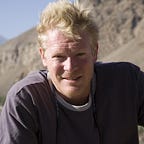The Moyo Diaries: 1
I’ll start off by admitting that I’ve never been a blogger. I’ve been lucky enough that my writing has mostly been for school or published books. I’ve written a few pieces here and there for Vanity Fair, SEED, MIT Tech Review and a few other publications, but I’ve mostly avoided the pull of blogging because I honestly haven’t had enough time.
However, I’ve decided to start chronicling my thoughts here because of the extreme circumstances the world finds itself in right now. The Coronavirus pandemic is raging around the world, having expanded from China into the Middle East, Europe, the United States, and soon South America and sub-Saharan Africa over the past two months. It’s a situation that is simply unparalleled in my lifetime — and probably yours as well. Scary AF.
Over the past few weeks I’ve Tweeted tons of stories gleaned from news sources I follow around the world, and made some prognostications about the course of the pandemic, most of which have unfortunately come true. I’m not trying to hold myself up as a sage — far from it — but I did study virology (including lab research on a mouse model for HIV, MoMLV) and epidemiology, and have been fascinated by emerging diseases ever since I read Laurie Garrett’s The Coming Plague in 1994.
I’ve always seen emerging zoonotic viruses as the ultimate example of “evolution in action” — a tiny genome encapsulated inside a tender fatty-protein membrane invading a human cell, hijacking its biochemical apparatus, reproducing, and than emerging to infect new cells and people. Along the way it picks up random mutations in its genome, adding variation to the immunologically detectable part of the virus, in the process helping it to infect ever more people. Fiendishly clever for something with a genome many orders of magnitude smaller than the one we carry inside our own cells and pass on to our children.
So how did a population geneticist end up on a remote eastern Indonesian island? Well, sit right back and you’ll hear a tale…a tale of a fateful trip… I was at National Geographic for over a decade as an Explorer-in-Residence (I know — Jane Goodall said the same thing when she became one: “An explorer should never be in residence!”) and director of the Genographic Project, and had the amazing opportunity to design and lead private jet trips circling the globe. For me it was a form of storytelling, enabling people to experience the people and places I’ve seen and worked in that have added to our knowledge of “The Human Journey.”
I led nine of these trips for NatGeo, and along the way learned what (IMHO) did and didn’t work. Tired: huge jets (757’s packed with 80+ passengers) and sights many intrepid travelers would have seen before. Wired: seeing places only a few people have ever traveled to, connected by strong storytelling, and being able to do it all by flying point-to-point rather than via commercial hubs with their missed connections and lost luggage. A 1% experience, to be sure, but a rare opportunity to see some of the word’s most amazing places.
So, a year ago my wife Holly and I created our own travel company, focused on a different kind of experience. I won’t go into details here — this isn’t a marketing plug — but sufficed to say, the trip we just undertook in Indonesia, crossing Wallace’s Line, was amazing.
Unfortunately, the Coronavirus went ballistic during the time we were in Indonesia. Our trip started on March 6th in Singapore, and by the evening of the 15th, when Singapore closed down its borders (entry only allowed with a 14-day quarantine), we knew the game was up. Our guests had intended to fly back home from the relatively safe southeast Asian city-state, but in order to avoid the uncertainty of a quarantine there we decided to cut short the trip and re-route to Bali, where they could catch a flight home via Dubai.
Happily, they have all arrived home safely, and they had a fantastic time — the two key goals of any trip. Holly and I were adamant about not returning to the United States, though. TSA agents coughing into their hands while asking for our passports at LAX on our trip over, for instance, as well as online reports about the excruciating multi-hour lines at major points of entry for travelers returning home in the past week, convinced us that we wanted to remain in Asia. But where? Singapore, arguably the safest port in the storm, would have quarantined us in a hotel room for 14 days. No thanks. Thailand, where Holly was born, holds a special connection — but I nixed mainland southeast Asia. Too many ways for the virus to spread across porous overland borders — islands are good in a pandemic.
So, we decided to come to one of our canceled final stops on the trip — Moyo Island. Largely a wildlife preserve — both above and below water — it seemed like the perfect place to sit out the pandemic. Accessible only by a 45-minute boat ride from Sumbawa, a small regional capital on a little-visited island (the primary industry is a gold- and copper-mining concession), I thought this would be the place to ride out the storm.
We arrived here two days ago, exhausted from spending 18 hours a day problem-solving. We’ve now settled in, done some snorkeling and diving, and gotten to know the staff. We’re not sure how long we will be able to stay, but we’ve agreed with the GM that we’re all in this together, and have bonded — a makeshift Indonesian family thrown together by circumstance. We’ll be growing our own food in the hotel’s kitchen garden, spear-fishing on the offshore reefs, cooking, and hoping we can keep the generator running to maintain the internet and much-needed air conditioning. The next few weeks are going to be an adventure, to be sure.
